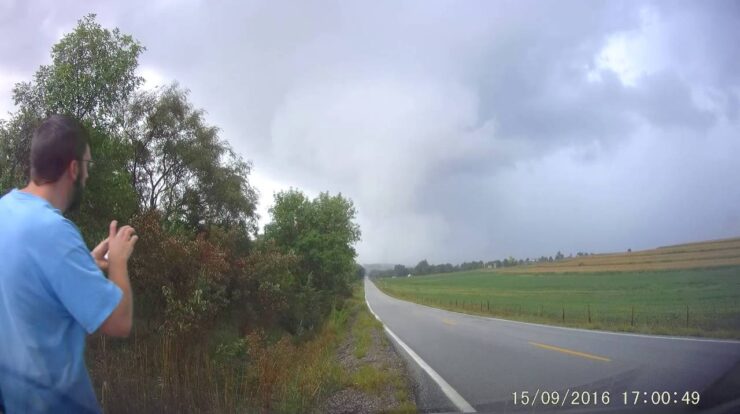
The Blair tornado, a destructive force of nature, left an unforgettable mark on the community. Its path of destruction serves as a stark reminder of the importance of preparedness and resilience in the face of extreme weather events.
This comprehensive report delves into the meteorological conditions that led to the formation of the tornado, the devastating impact it had on infrastructure and the environment, and the inspiring response and recovery efforts that followed.
Historical Overview of the Blair Tornado

The Blair tornado was a violent and destructive EF4 tornado that touched down near the town of Blair, Nebraska, on May 31, 2014. It was part of a larger outbreak of tornadoes that swept across the Midwest that day, causing widespread damage and loss of life.
The tornado first touched down at 4:55 p.m. CDT, just east of Blair. It quickly grew in strength and intensity, reaching peak winds of 170 mph (270 km/h). The tornado traveled for approximately 13 miles (21 km), leaving a path of destruction in its wake.
The tornado caused extensive damage to Blair and the surrounding area. Hundreds of homes and businesses were destroyed, and several people were injured. The tornado also caused significant damage to infrastructure, including roads, bridges, and power lines.
The Blair tornado was a tragic event that had a profound impact on the community. However, it also demonstrated the resilience and strength of the people of Blair. In the aftermath of the tornado, the community came together to help those who had been affected, and to rebuild the town.
Anecdotes and Personal Accounts
One of the most memorable anecdotes from the Blair tornado is the story of a young girl named Sarah. Sarah was at home with her family when the tornado struck. She and her family took shelter in their basement, and they were miraculously unharmed.
Sarah’s story is just one of many that illustrate the courage and resilience of the people of Blair. In the face of adversity, they came together to help each other and to rebuild their community.
Meteorological Conditions and Formation: Blair Tornado
The Blair tornado formed in an environment that was ripe for severe weather. The day was hot and humid, with high temperatures in the mid-80s (Fahrenheit). The atmosphere was also unstable, with a strong temperature gradient between the surface and the upper atmosphere.
In addition, there was a strong wind shear in the atmosphere, which is a change in wind speed and direction with height. This wind shear helped to create the rotation that is necessary for tornado formation.
The Blair tornado was a classic supercell tornado. Supercell tornadoes are the most powerful and long-lived type of tornado. They are characterized by their rotating updraft, which can reach speeds of over 100 mph (160 km/h).
The Blair tornado had a well-defined funnel cloud that was visible for several minutes before the tornado touched down. The tornado was also accompanied by a loud roar, which is a common characteristic of supercell tornadoes.
Response and Recovery Efforts
The Blair tornado caused widespread damage and destruction, and the community was quick to respond. Emergency services personnel were on the scene within minutes, and they worked tirelessly to rescue survivors and clear debris.
The community also came together to help those who had been affected by the tornado. Volunteers set up shelters, provided food and clothing, and helped to clean up the damage.
The recovery from the Blair tornado was a long and difficult process. However, the community’s resilience and determination helped to rebuild the town and to restore a sense of normalcy.
Challenges
The response and recovery efforts in Blair were not without their challenges. One of the biggest challenges was the lack of resources. The tornado had caused significant damage to infrastructure, and this made it difficult to get supplies and equipment to the affected areas.
Another challenge was the weather. The tornado had struck in the late afternoon, and the weather was still severe. This made it difficult for emergency services personnel to work safely and efficiently.
Examples of Resilience and Community Support, Blair tornado
Despite the challenges, the people of Blair came together to help each other in the aftermath of the tornado. Volunteers worked tirelessly to clear debris, provide food and clothing, and set up shelters.
One example of the community’s resilience is the story of a group of volunteers who worked to rebuild a local church that had been destroyed by the tornado. The volunteers worked long hours, and they were able to rebuild the church in just a few months.
Impact on Infrastructure and Economy
The Blair tornado caused significant damage to infrastructure and the economy. The tornado destroyed hundreds of homes and businesses, and it also damaged roads, bridges, and power lines.
The economic impact of the tornado was also significant. The tornado caused an estimated $1 billion in damages, and it disrupted businesses and livelihoods.
Long-Term Recovery Plans
The Blair tornado had a long-term impact on the community. The town had to rebuild its infrastructure, and businesses had to find new ways to operate.
The community also had to address the psychological impact of the tornado. Many people were traumatized by the experience, and they needed help to recover.
Environmental and Ecological Impact

The Blair tornado also had a significant impact on the environment and ecology of the area. The tornado destroyed trees and vegetation, and it also polluted the air and water.
The tornado also caused significant damage to wildlife. Many animals were killed or injured, and their habitats were destroyed.
Conservation Efforts
The Blair tornado highlighted the importance of conservation and environmental protection. In the aftermath of the tornado, the community worked to restore the damaged ecosystems.
One example of the community’s conservation efforts is the planting of trees. Volunteers planted hundreds of trees to replace those that had been destroyed by the tornado.
Lessons Learned and Preparedness

The Blair tornado was a tragic event, but it also taught valuable lessons about preparedness and mitigation. The tornado highlighted the importance of early warning systems, evacuation plans, and community education.
In the aftermath of the tornado, the Blair community worked to improve its preparedness for future events. The community installed a new early warning system, and it developed new evacuation plans.
The Blair community also worked to educate its residents about tornadoes and how to stay safe. The community held tornado drills and safety workshops, and it distributed educational materials.
Best Practices in Tornado Preparedness and Mitigation
The Blair tornado demonstrated the importance of being prepared for tornadoes. There are a number of things that individuals and communities can do to prepare for tornadoes, including:
- Developing a tornado safety plan
- Knowing the signs of a tornado
- Having a safe place to go in the event of a tornado
- Practicing tornado drills
- Staying informed about weather forecasts
Ultimate Conclusion
The lessons learned from the Blair tornado provide valuable insights for communities across the globe. Early warning systems, evacuation plans, and community education are essential elements of tornado preparedness. By embracing these measures, we can mitigate the impact of future tornadoes and protect lives and property.
Question & Answer Hub
What caused the Blair tornado?
The Blair tornado formed due to a combination of atmospheric instability, wind shear, and other meteorological conditions.
What was the impact of the tornado on the community?
The tornado caused significant damage to buildings, infrastructure, and the natural environment, resulting in loss of life and property.
How did the community respond to the tornado?
Emergency services and community members worked tirelessly to provide immediate assistance, coordinate relief efforts, and support recovery operations.
What lessons were learned from the Blair tornado?
The tornado highlighted the importance of early warning systems, evacuation plans, and community preparedness in mitigating the impact of future tornadoes.






